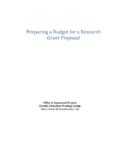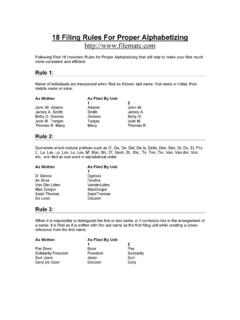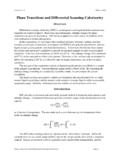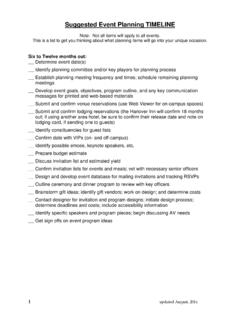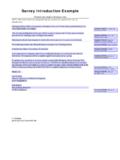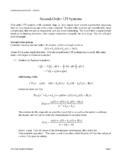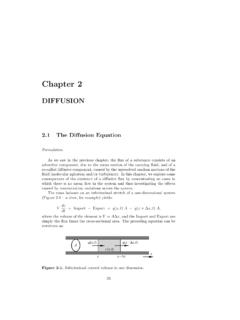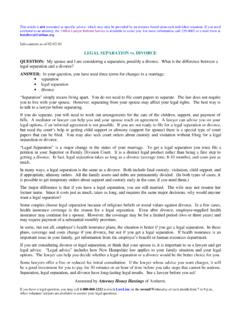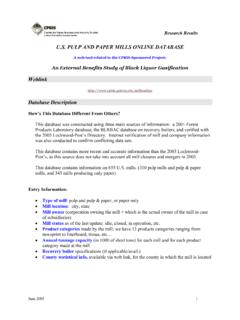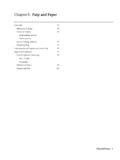Transcription of FOREST AND PAPER INDUSTRY - dartmouth.edu
1 1 FOREST AND PAPER INDUSTRYA mature INDUSTRY that has done much to clean up its are the primary environmental issues concerning the FOREST and PAPER INDUSTRY ?1. Sustainability of FOREST resources: trees + habitats + species + water2. Clean PAPER making: transportation to and from PAPER millenergy consumptionwater usagebleaching and other chemicals3. PAPER consumption: Can it be reduced?4. Recycling of used PAPER and cardboardenergy, chemicalsrecycling vs. incineration5. Alternatives to wood for PAPER ?Alternatives to PAPER itself? PAPER is a commodity: low design, near impossibility of changing the product itselfhuge amounts huge impact nonethelessPaper accounts for of industrial of world tradePaper consumption is related to populationand to , we consume more PAPER than others.
2 Why? : PAPER consumption is highly correlated with a wide range of countriesZoom on the less wealthy countries (bottom left of previous plot)5 PAPER consumption and GDP relation (Diesen 2007)Look at historical data: GNP is about the only factor affecting PAPER , roughly, PAPER consumption is occurring according to:70 metric tons70 grams / $$1 million of GNP With a footprint of g of CO2per kg of PAPER produced, g of kg of g of CO / $$1kg of PAPER Around 80% off all products sold in United States and the European Union are packaged in cardboard. In the United States, 850 million tonnes of PAPER and cardboardare thrown away equates to around 1 billion trees, a terrifyingly high put this into further perspective, the average American uses around seven trees per year in PAPER and cardboard.
3 MoreSource:Amazing Facts about Cardboard Waste & few numbers from How Bad Are Bananas? The Carbon Footprint of Everythingby Mike Berners-Lee, GreyStone Books, 2011 ItemCarbon footprintBrown grocery bag12 g CO2eFancy PAPER bag from department store80 g CO2ePaperback book on recycled PAPER *400 g CO2eBook on thick virgin PAPER **2 kg CO2eDaily newspaper on recycled kg CO2eNYT Sunday PAPER , recycled kg CO2eRoll of toilet PAPER (recycled/new PAPER )**450/730 g CO2e* Assuming all printed copies are sold** Assuming half printed copies are pulped** Amounting to 75 kg/person in US1 ton of uncoated virgin (non-recycled) printing and office PAPER uses 24 trees 1 ton of 100% virgin (non-recycled)
4 Newsprint uses 12 treesA "pallet" of copier PAPER (20-lb. sheet weight) contains 40 cartons and weighs 1 ton. Therefore, 1 carton (10 reams) of 100% virgin copier PAPER uses tree makes reams of copy PAPER or 8,333 ream (500 sheets) uses 6% of a ton of coated, higher-end virgin magazine PAPER (as used for high-end magazines) uses a little more than 15 trees ( )1 ton of coated, lower-end virgin magazine PAPER (used for newsmagazines and most catalogs) uses nearly 8 trees ( )(Source: )8 PAPER Task Force, 1995 Environmental defense FundIn brief,Tree trunks = woodWood = Fibers + Lignin (glue) pulp = Loose fibers in waterPaper = dried pulp in sheet formThe longer the fibers, the stronger the shortens the average length of small batch of pulpWood fibers (magnified)9 From woodTo pulpFrom pulpTo paper1.
5 FOREST logging10A tree = 25% branches and bark75% trunk wood logs16 to 20 mature trees per acreWood log = 27% lignin (glue)73% fiber (what goes into PAPER )Every tree requires130 gallons (490 L) of water for growth50 gallons (189 L) of water for processing into paperBasic rule:Trees cut + trees lost to FOREST fires and diseases < trees reaching maturity(on annual basis)But ..- Mind soil erosion- Mind habitats- Mind aestheticsIn other words, cut in an environmentally conscious Balance the various FOREST resources:- Lumber and firewood- PAPER - RecreationDartmouth College does a great job balancing these several objectives in its Second Grant Land in northern New most environmentally conscious form of logging is with draft horses, especially when a snow cover is PapermakingThe production of 1 metric ton of PAPER requires17 trees (in average)24 trees for white office PAPER , 12 trees for newsprint25 m3of water51,500 MJ of energy10,061 kWh of electricity680 gallons ( m3)
6 Of oil13logschipschipspulpbleached pulppapersteamFrom logs to chipsSome brute force is energy consumption14 From chips to pulpHere, the process is purpose of this step is to remove the lignin (= glue) that holds the wood fibers together. The product is loose fiber in water, called used chemicals to new chemicals15 Various bleaching technologiesusing Cl2 ECF = Elemental Chlorine Free(use of ClO2instead of Cl2)TCF = Total Chlorine Free (incl. ozone)using chlorine ClO2no Cl in any form ECF bleaching substantially reduces but does not fully eliminate chlorinated organic compounds, including dioxins, from the effluent. TCF bleaching, by removing chlorine entirely from the process, eliminates chlorinated organic compounds in the = Elemental Chlorine Free (substitution of Cl2by chloride dioxide ClO2)TCF = Total Chlorine Free (no Cl in whatever form, use of O3and H2O2instead)The ECF vs TCF debate.
7 Arguments pro-ECFA rguments pro-TCFor against TCFor against ECFTECHNOLOGY- ClO2gives better bleaching- TCF technology exists- ECF fibers are stronger- Easier to start/stop facility- Water loop can be closed- Cl builds in closed loops corrosion leaks- Efficiency of H2O2is not greatENVIRONMENT- ECF is good enough*- TCF = only guarantee against - Anti-Cl position is like a religionrelease of Cl compounds- Stronger fibers- Easier to filtrate effluents fewer trees & more recycling- Theoretical possibility of - ECF generates no dioxin in practiceproducing dioxin from ECFMARKET- Weaker PAPER from TCF- Strong European demand - Low demand for TCF in USAfor TCF PAPER - European demand may not lastECONOMICS- Too costly to retrofit an existing - Not more expensive to go plant from ECF to TCFTCF when building a new facility- Higher production costs with TCF incl.
8 Cutting more trees* with primary and secondary treatment of wastewater163. Recycling17 First off: Is it better to recycle than to incinerate or landfill?- Recycling re-use of fibers but energy spent in transportation and remanufacture- Incineration Getting energy without as much transportationEnergy produced displaces fossil-fuel energybut cascading not as good as recycling, in principleAlso: particulate air emissions!- Landfilling Least effort but methane emissions during decompositionIn general, landfill is the least preferable option, and there are conflicting opinions regarding incineration versus most cases, recycling results in lower total energy cost but with a greater fraction coming from fossil = Lower emissions during recycling than during incinerationS = Same emissions during recycling as during incinerationH = Higher emissions during recycling than during incineration18 Recycled versus virgin PAPER :Producing recycled PAPER involves between 28 70% less energy consumption than virgin PAPER and uses less water.
9 This is because most of the energy used in papermaking is in the delignification of wood into pulp . Recycling only needs de-inking before PAPER produces fewer polluting emissions to air (95% of air pollution) and water. Recycled PAPER is not usually re-bleached and where it is, oxygen rather than chlorine is usually used. This reduces the amount of chlorinated compounds which are released into the environment as a by-product of the chlorine bleaching processes. additional reason to recycle PAPER : There is a lot of it in your garbage, and it adds to landfill ton of PAPER recycled saves more than cubic yards (~3 m3) of landfill : issues faced in PAPER /cardboard recycling:- Collection & Sorting- Transportation to sorting/recycling center- Recycling process itself: de-inking, loss in fiber strength, hazardous chemicals- Marketing of recycled paperChallenges in collection and sorting.
10 - Impossibility to capture all forms of PAPER used by consumersHygienic PAPER , waxed PAPER are not recyclableHarder to collect from individuals than from companies- What is captured ought to be sorted in grade categoriesP&W = printing and writing(white office PAPER )OCC = old corrugated cardboardONP = old newspapersMixed PAPER - White office PAPER has the highest grade for recycling but is relatively hard to collect. Offices hang on to documents. Often mixed with magazines, which has the lowest grade (glossy, colors).- Old newspapers are also relatively easy to capture because people pile them up at they are now a vanishing Collection of corrugated cardboard boxes is relatively easy in the back of retail stores such as handy Post-It A previous and now solved issueRecycling of PAPER or cardboard when no de-inking does needs to be done22( )If de-inking is involved:Percentage of post-consumer PAPER recycling in the USA Total PAPER recovery in the exceeded 51 million tons in 2012.
